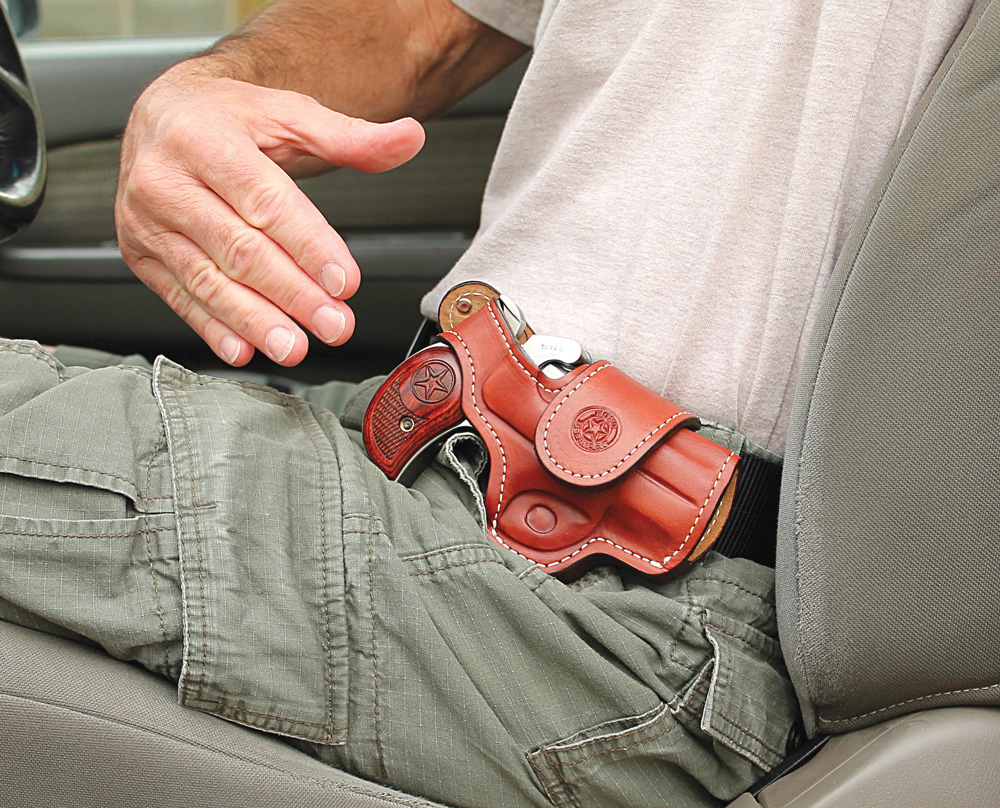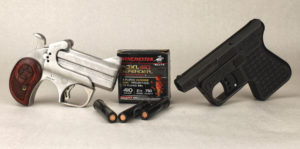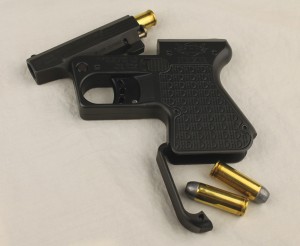

Are these small but powerful firearms — call them hand cannons or pocket shotguns — just market hype or true mighty midgets for concealed carry?

The newest modern derringers are now essentially the same caliber as Henry Deringer’s first pocket pistol of 1852. Back then, the muzzleloading single-shot Philadelphia Deringer used 15 to 25 grains of black powder to drive a .41 caliber round ball. Since those days, derringers have been chambered for many handgun cartridges, but only fairly recently have they been made to shoot the .410 shotshell.
Are these modern pocket shotguns and hand cannons just gimmicks or are they really viable for self-defense? To answer that, we need to know if .410 ammunition can stop an attacker. Also we need to know if the derringer has the physical characteristics suitable for concealed or pocket carry, and if the derringer is controllable in pointing and in recoil.
Hand Cannon Ammo
One selling point for these handguns is the happy coincidence that chambers can be made to fit both .45 Colt cartridges and .410 shotgun shells (though rim diameter and thickness is not identical), providing a “twofer” benefit. However, because .45 Colt bullet diameters vary from .452 to .454 inches, and factory loads can measure as small as .440 inches, you must be sure that yours properly fits the groove diameter of your pistol, otherwise you could suffer unacceptable accuracy and reduced penetration.
The specific derringers examined here have rifling groove diameters of .450 inches (Bond Arms) and .452 inches (Heizer Defense PS1), so you should use bullets of not less than those diameters and not more than about .0005 inches over.
While small shot like No. 9 through No. 1 may stop an attacker up close, it may be less likely to instantly incapacitate than the buckshot sizes 00 and 000, especially as distance increases.
Three to five 00 balls will fit in a .410 shell, depending on whether it is 2 inches or 3 inches long. Stepping up to 000, three or four fit in a 2-inch shell and five can get into a 3-inch shell; it varies with the maker.
Winchester’s PDX 410 Defender ammo, used for testing and now marketed as just Defender, goes a slightly different route, being loaded with three full-caliber, plated lead discs on top of 12 pellets of plated BB shot (larger than #1, but smaller than buckshot). While not an exhaustive evaluation, it’s a starting point for testing defense-specific ammo.
Unfortunately, there is just about zero data from real-life shootings using .410 pistols because they are so new to the world of defensive handguns. Still, it seems likely that striking an attacker a few feet away with multiple .35 to .41-caliber bullets would be effective.
The Guns

Life is full of tradeoffs. We chose a derringer for its size, knowing we must forego fine sights, full-size grips, backup shots and the effective range of other carry guns. We tested two .410 derringers, the Bond Arms double barrel and the single-barrel Heizer Defense PS1.
Each maker approaches the derringer concept differently, and it’s up to the individual shooter to decide which features are most desirable. Both pistols here chamber only the 2-inch shotshell. Trigger pull weights, by design, are intentionally heavy and exceeded the capacity of spring-type gauges.
Bond Arms
The Bond Arms derringer is a hefty 19.9-ounce chunk of stainless steel and has a very short bird’s-head grip with a smooth backstrap.
Couple that with expected sharp recoil, and the first inclination is to settle the gun too low in the hand and grip the trigger at the first knuckle of the index finger. But allowing the web of your hand to press against the cocked hammer can increase trigger pull weight. So hold the derringer as you would your other pistols, with an imaginary straight line running from the front sight to your elbow and only the pad of your finger in the trigger face.
This is a single action (SA) pistol requiring thumb cocking of the hammer before firing. With practice it doesn’t have to add any time to present the pistol to the target, but the handgun’s ergonomics and the considerable effort needed for thumb cocking must suit your hand size and strength.
If too large or too hard for you to cock, you may find yourself unintentionally squeezing the trigger while cocking. The wide, serrated hammer spur aids in cocking but it can snag on clothing during the draw unless you cover the hammer with your thumb upon drawing from a holster or pocket.
The pistol’s cross-bolt safety is not readily disengaged with one hand, especially if you’re in a hurry. For carry, turning a screw locks the safety in the off position. The Bond Arms loads safely with the hammer down. Because the 3-inch barrel assembly is hinged at the top, shells and cartridges will slide out when closing the action, unless you tip the pistol on its side or slightly invert it.
The Heizer Defense PS1

The most immediately notable feature of the PS1 is its 1/2-inch wide, flat profile, totally lacking any protrusions other than the low front sight. Clearly, the snag-proof, melted-edge design is intended specifically for pocket carry, though the maker includes a list of holsters that fit the PS1. Barrel length for the .410 is 3 inches and the weight is 21.4 ounces. The only operating control other than the trigger is the ambidextrous recessed barrel release. A spring-loaded extractor pushes cases from the chamber far enough to grasp with the fingers.
The trigger pull is long and stacks at the end as the striker spring compresses. The trigger is adequate for the pistol’s purpose. The .45 Colt rim diameter is slightly smaller than the .410. Several times during loading with the barrel pointed down, .45 Colt cartridge rims slipped past the extractor; when this happens it’s impossible to close the action.
These are truly diminutive guns, and even the smallest hands won’t get a pinky finger on either grip. The PS1 has the edge for shooters with weaker hands who may find the Bond Arms pistol difficult to thumb cock. If gripping with both hands Weaver style, placing your offhand index finger on the front of the trigger guard of either pistol puts it a fraction of an inch from the muzzle, so extra caution or changing your grip is in order.
Shooting Results

Both guns patterned well at 7 feet, placing multiple hits close to center mass. As expected; however, at 21 feet the shot from the short barrels spread so much as to render hits iffy though several still landed at center mass.
The rifling in each barrel apparently caused shot to favor to the left.
These are utilitarian self-defense handguns, not something you’ll shoot often for pleasure. And frankly, in .410 they are not a pleasure to shoot; the PS1’s slim grip made recoil particularly uncomfortable. A few rounds for regular practice and familiarity are necessary but anything more than that would be punishing.
Bottom Line
Derringers are intended for convenient carry and up-close defensive situations. An across-the-room shot is fairly long, with accuracy and instant incapacitation decreasing rapidly with distance. There are better choices for home defense. Protracted gunfights are obviously not an option with derringers. If firepower is your priority then Bond Arms gets the nod with two immediate shots; if non-snag pocket carry concealment is number one, then the PS1 has a clear design advantage.
Blast Through the Basics: All About Shotguns
- Best AR Shotgun – Best Picks And Buyer’s Guide
- 410 Pump Shotgun Reviews – Best .410 Bore Shotguns
- Affordable Over Under Shotguns – A Buyer's Guide
- Best Semi Auto Shotguns – Scatterguns For The Field And Defense
- Best Double Barrel Shotgun Guide
- 8 Gauge Shotguns – Exploring Their Role in Shooting History
- Top Tactical Shotguns Our Picks for the Best Models
- History of Lever Action Shotguns
- Top Rated Pump Action Shotguns – A Buyer's Guide
- Best Bullpup Shotguns for Home Defense
This article also appeared in the November 20, 2014 issue of Gun Digest the Magazine.

Next Step: Get your FREE Printable Target Pack
Enhance your shooting precision with our 62 MOA Targets, perfect for rifles and handguns. Crafted in collaboration with Storm Tactical for accuracy and versatility.
Subscribe to the Gun Digest email newsletter and get your downloadable target pack sent straight to your inbox. Stay updated with the latest firearms info in the industry.

![Best Concealed Carry Guns In 2025 [Field Tested] Wilson Combat EDC X9S 1](https://gundigest.com/wp-content/uploads/Wilson-Combat-EDC-X9S-1-324x160.jpg)


![Best 9mm Carbine: Affordable PCCs [Tested] Ruger Carbine Shooting](https://gundigest.com/wp-content/uploads/Ruger-Carbine-Shooting-100x70.jpg)
![Best AR-15: Top Options Available Today [Field Tested] Harrington and Richardson PSA XM177E2 feature](https://gundigest.com/wp-content/uploads/Harrington-and-Richardson-PSA-XM177E2-feature-100x70.jpg)

To lessen chances of accidently hitting an “innocent”, I’ve been training to drop to one knee, (when reasonable), before firing. This grants an upward angle to trajectory. As with my bedside weapon, I prefer the taurus judge since it affords me the option of firing .410 to lesson risk to others behind walls or down range from my target. I also chose the revolver to diminish/eliminate prefire steps, ( is the safety on? is there a round in the chamber?). waking up to immediate danger, I prefer just grabing, zeroing on threat and firing. I appreciate any input to the above, since it’s possible for one person to overlook additional risk/short-sightedness.
Oh, yea, one other thing. Makle sure that the big-ol-magnum you decide to carry wn’t shoot through the bad guy and kill or injure an innocent bystander.
Yes, it happens.
Big, heavy, slow moving bulets that stay IN the body will cause the shock- or blood loss and brain death if they are on pain killing/blocking drugs- that will actually put someone down to stay.
And you cannot rely on ANY gell test for ballists you have ever seen. Why?
Simple. Where are the bones [internal armour] in the human chest that you need to actually shoot through, since you have been trained to shoot to center of mass? Where is the heavy jacket/vest/coat that they are nearly always wearing when they do someting stoopid?
Back to the heavy slow bullet: even if it does not get to the vitals, it will put them down on their ass where you now have even greater advantage.
What big heavy bullet is the 45ACP shooting? I have 325gr 45LC rounds. Either way, neither is the size of a pie plate, so how is knocking the person down? But as you said in your first post; you’ve have rarely needed to pull your gun and not had to shoot it. So, it really doesn’t matter much which you carry does it? Intimidating, what is intimidating . . . probably the size of the hole in the barrel and two holes are probably more intimidating than one. Lastly, most people who carry a derringer, are probably using it as a back up or are in a place where carrying a full size is not a possibility.
Two problems:
First: One or two barrels is fine if you are an expert shot, you are only facing one or two people who do not have you outgunned and are not high on somethig that stops their pain receptors from working, or their sense of impending death from stopping them first.
Second: Ever since Thompson Center came out with the Contender in .45 COLT..410 caliber [not a ‘shotgun gauge’] people have been trying to make it work RIGHT, and that was about 30 years ago.
So, you have a .451/.452 bore, and a .410/.411 shot wad… not very stable, not terribly reliable for a quick stop on a possibly drug addled attacker… with only two barrels.
So, you have a .45 COLT, but the bullet needs to make a nearly 2″ jump to the forcing cone, where you loose a BUNCH of power due to the burning powder blowing around the bullet before it gets to the forcing cone- which gives it a chance to upset before it slams into the rifling… with only two barrels. Really? A good choice?
Now take that an put it back into a single shot… again, not very reliable as a man stopper. Again. not a good choice.
I am 5’6″, and I have been carrying a full size 1911 Gov’t model, steel frame, absolutely concealed, for the better part of 33 years, and that is a bullet large enough, with a total of nine rounds- with two backup mags- to actually come out of a bad situation with my skin intact.
Fortuantely, in civillian life, I have not needed to pull the triger over the four times I have needed to pull that handgun from concealment. Fortunatle the bad guys had the presence of mind to realize that a 1911 could easily end their existance.
Which brings me to Three: Intimidation nearly always works, and if your defensive firearm is not intimidating, it is much less likely to make a bad guy change his mind, an that is IF he/they ain’t armed with more than you have in your hand.
There is no doubt a 454, 460 or 500 is capable of taking out large prey, but they also are not Pocket Cannons, especially if you want to utilize their full power potential; which would mean you have a full length barrel not a short one. I agree, my S&W460V is surely more like a cannon, but a 45LC or 3″ 410 out of derringer is a lot more cannon like than a 22, 25, 32 or 38 from a derringer.
Those little guns don’t even deserve to be called “handcannons”. A Ruger Super Redhawk Alaskan in .454 Casull is most definitely a “handcannon”. I’ve shot a .410 out of a small deringer and, well if us wanna pick off hummingbirds at the feeder then you’ve got your weapon. If I go into snake or other violent little critters country I’m going to be packing a Mossberg Chainsaw. As far as actual “handcannons” then get the biggest, hardest walloping gun and cartridge you can handle. Whenever I go deep woods or bear country I take my .454 Alaskan
Snake Slayer IV for 2ndary carry, hiking companion and long road trips. Go with the oversized (not Jumbo) grip and the new rubberized one does wonders at reducing felt recoil, especially with 3″ 410 shells. I like the #4 (9 pellet) buckshot by Federal, a reasonable compromise between larger birdshot and large buck 00 / 000. After all, it’s like being shot with 9 .24 caliber rounds at once. I will usually carry with one of those and them one 000 3″ loaded. If you want to get practice in, buy the 22LR replacement barrel, gives you trigger time with a lower cost and no recoil. I haven’t experienced any left or right shooting issue, but it definitely has one barrel on target and the other is off by a good 6 inches. I generally practice between 3 and 5 yards and have done some at 7 yards. Silhouettes are no problem to keep shots on target at those distances. Done quite a bit of 45 Colt practice as well and it is fun. If you want to reduce recoil without changing the grip, get a pair of lightweight leather shooting gloves, even wearing only one will help if you want to do some longer practice sessions. I would certainly recommend buying one of these if you have the resources and hike. It’s a good weapon to carry loaded with birdshot for smaller critter / snake control.
Very happy to finally see an article on bond for self defense. I carry the bond snake slayer IV with pdx1 rounds.